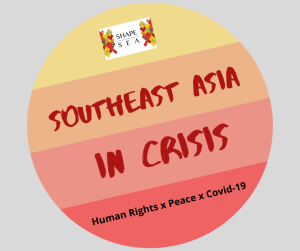Guanie Lim and Chan-Yuan Wong
 Guanie Lim is Research Fellow at the Nanyang Centre for Public Administration, Nanyang Technological University, Singapore. His main research interests are comparative political economy, value chain analysis, and the Belt and Road Initiative in Southeast Asia. Guanie is also interested in broader development issues within Asia, especially those of China, Vietnam, and Malaysia. In the coming years, he will be conducting comparative research on how and why Chinas capital exports are reshaping development in two key developing regions “ Southeast Asia and Middle East and North Africa. He can be reached at guanie.lim@gmail.com. Chan-Yuan Wong is Associate Professor at National Tsing Hua University, Taiwan. His research interests are economics of technology catching-up, science and public policy and regional innovation systems in Asia. He can be reached at wcy@mx.nthu.edu.twAs Southeast Asia struggles to contain the spread of the COVID-19 pandemic in 2020, various social distancing measures were rolled out aggressively across the region. The measures, however, were costly as workplaces were shuttered and employees furloughed. To reflate the rapidly slowing economy, aggressive pump-priming policies were implemented in quick succession. Thus far, policymaking focus in the region has been primarily on job preservation “ extending financing support to firms and individuals alike (Khor and Strauch, 2020).With many of the regional economies entering (or about to enter) recession, recovery to pre-COVID-19 levels will take time. While we laud the quick actions of the regions healthcare workers and policymakers, we would like to also raise awareness on the situations ˜human side. Notwithstanding the dismal economic performance indicators, we cannot forget that what is fundamentally at stake here are people, often from the most vulnerable segments of society.Unpacking the IssuesFirstly, COVID-19 affects the disadvantaged disproportionately more than the rest. Although it is fairly common to conceptualize the disadvantaged versus privileged divide along income lines, what often goes unmentioned is the way such inequalities play out along spatial dimensions. For example, as universities adopt digital, off-site learning, it is inevitable that students living in remote areas with poor infrastructure struggle more with this development than those in urbanized areas. In the eastern Malaysian state of Sabah, a university student who went out on a limb “ going as far as climbing a tree “ to ensure she had good internet connection to sit her exams online has impressed many with her resourcefulness (BBC, 2020). Neither is this divide absent in an urban area. In the Philippines, years of internal migration from provincial job seekers into Metro Manila has created urban slums with poor hygiene standards. Following the onset of COVID-19, the city has been stretched to the limit, with fears of a collapse of the healthcare system from soaring infections (Reuters, 2020).Secondly, the pandemic has exposed the limits of how our growth model has been fuelled partly by a dependence on semi-skilled labour. Southeast Asias rather high mobility of labour means that many of us have grown dependent on importing labourers (usually from adjacent lower cost economies), often to undertake professions that the locals shun (Kanchoochat, 2017). Compounding the issue is the porous border control of some of the regions economies, leading to a large ˜shadow labour force keeping labour-intensive, low-wage (but critical) industries afloat. Examples include the Malaysian palm oil industry and the Thai textile industry (Wong and Lim, 2020). Despite inadequate paperwork and workplace welfare, this particular labour pool has developed an almost symbiotic relationship with their host economies over the decades. Hard hit by the crisis, these labourers have struggled to make ends meet, in addition to an inability to retreat to their countries of origin, when workplaces and borders shut down.Way ForwardWe propose two inter-related approaches in tackling as well as moving on from COVID-19. Firstly, we suggest a more ˜spatial perspective in tackling development issues. To this end, we encourage policymakers and researchers to ˜look beyond the numbers, adopting a more unorthodox manner in analysing development-related subjects such as infrastructure provision and income redistribution. Although the overall aim is to raise living standards, the reality is that socioeconomic gains tend to be highly uneven, with the less privileged (e.g. those in the rural areas and ghettoized parts of a highly urbanized zone) getting disproportionately less. These structural factors have always been present, but have to be more carefully unpacked as we move forward. A useful policy avenue is to consider more decentralized governance, shifting responsibilities down to the local level authorities and moving away from the ˜top-down approach of yesteryears (Malesky and Hutchinson, 2016).Lastly, there is an urgent need to rethink labour needs with reference to the regions vastly different stages of economic development. For each of the Southeast Asian economies, we have to understand the root causes behind the avoidance of certain professions and address them appropriately. If large numbers of foreign, semi-skilled workers are still required, then there is a need to ensure proper documentation and records. Done correctly, the hitherto ˜shadow labour force can be gradually formalized into the relevant demography, which facilities long-term industrial planning. In addition, long-overdue welfare measures can be introduced for this vulnerable group.References:BBC. (2020). Malaysian Student Sits Exams in a Tree to ensure Good Wifi. BBC. Available at: https://www.bbc.com/news/blogs-news-from-elsewhere-53079907Kanchoochat, V. (2017). ˜Towards a Southeast Asian Variety of Capitalism? In Southeast Asia beyond Crises and Traps: Economic Growth and Upgrading, edited by B.T. Khoo, K. Tsunekawa and M. Kawano, 277-295. Cham: Springer.Khor, H.E. and Strauch, R. (2020). Why Asia and Europe Are Responding to the Same Crisis Differently. Project Syndicate. Available at: https://www.project-syndicate.org/commentary/asean-3-eurozone-covid19-crisis-response-by-ho-ee-khor-and-rolf-strauch-1-2020-08?barrier=accesspaylogMalesky, E. and Hutchinson, F. (2016). Varieties of Disappointment: Why Has Decentralization Not Delivered on Its Promises in Southeast Asia? Journal of Southeast Asian Economies, 33(2): 125-138.Reuters. (2020). Philippines to Update COVID-19 Strategy as Healthcare Workers Seek ‘Timeout’. Reuters. Available at: https://www.reuters.com/article/us-health-coronavirus-philippines/philippines-to-update-covid-19-strategy-as-healthcare-workers-seek-timeout-idUSKBN24Y07DWong, C.-Y. and Lim, G. (2020). A Typology of Agricultural Production Systems: Capability Building Trajectories of Three Asian Economies. Asia Pacific Viewpoint, 61(1): 37-53. doi:10.1111/apv.12220
Guanie Lim is Research Fellow at the Nanyang Centre for Public Administration, Nanyang Technological University, Singapore. His main research interests are comparative political economy, value chain analysis, and the Belt and Road Initiative in Southeast Asia. Guanie is also interested in broader development issues within Asia, especially those of China, Vietnam, and Malaysia. In the coming years, he will be conducting comparative research on how and why Chinas capital exports are reshaping development in two key developing regions “ Southeast Asia and Middle East and North Africa. He can be reached at guanie.lim@gmail.com. Chan-Yuan Wong is Associate Professor at National Tsing Hua University, Taiwan. His research interests are economics of technology catching-up, science and public policy and regional innovation systems in Asia. He can be reached at wcy@mx.nthu.edu.twAs Southeast Asia struggles to contain the spread of the COVID-19 pandemic in 2020, various social distancing measures were rolled out aggressively across the region. The measures, however, were costly as workplaces were shuttered and employees furloughed. To reflate the rapidly slowing economy, aggressive pump-priming policies were implemented in quick succession. Thus far, policymaking focus in the region has been primarily on job preservation “ extending financing support to firms and individuals alike (Khor and Strauch, 2020).With many of the regional economies entering (or about to enter) recession, recovery to pre-COVID-19 levels will take time. While we laud the quick actions of the regions healthcare workers and policymakers, we would like to also raise awareness on the situations ˜human side. Notwithstanding the dismal economic performance indicators, we cannot forget that what is fundamentally at stake here are people, often from the most vulnerable segments of society.Unpacking the IssuesFirstly, COVID-19 affects the disadvantaged disproportionately more than the rest. Although it is fairly common to conceptualize the disadvantaged versus privileged divide along income lines, what often goes unmentioned is the way such inequalities play out along spatial dimensions. For example, as universities adopt digital, off-site learning, it is inevitable that students living in remote areas with poor infrastructure struggle more with this development than those in urbanized areas. In the eastern Malaysian state of Sabah, a university student who went out on a limb “ going as far as climbing a tree “ to ensure she had good internet connection to sit her exams online has impressed many with her resourcefulness (BBC, 2020). Neither is this divide absent in an urban area. In the Philippines, years of internal migration from provincial job seekers into Metro Manila has created urban slums with poor hygiene standards. Following the onset of COVID-19, the city has been stretched to the limit, with fears of a collapse of the healthcare system from soaring infections (Reuters, 2020).Secondly, the pandemic has exposed the limits of how our growth model has been fuelled partly by a dependence on semi-skilled labour. Southeast Asias rather high mobility of labour means that many of us have grown dependent on importing labourers (usually from adjacent lower cost economies), often to undertake professions that the locals shun (Kanchoochat, 2017). Compounding the issue is the porous border control of some of the regions economies, leading to a large ˜shadow labour force keeping labour-intensive, low-wage (but critical) industries afloat. Examples include the Malaysian palm oil industry and the Thai textile industry (Wong and Lim, 2020). Despite inadequate paperwork and workplace welfare, this particular labour pool has developed an almost symbiotic relationship with their host economies over the decades. Hard hit by the crisis, these labourers have struggled to make ends meet, in addition to an inability to retreat to their countries of origin, when workplaces and borders shut down.Way ForwardWe propose two inter-related approaches in tackling as well as moving on from COVID-19. Firstly, we suggest a more ˜spatial perspective in tackling development issues. To this end, we encourage policymakers and researchers to ˜look beyond the numbers, adopting a more unorthodox manner in analysing development-related subjects such as infrastructure provision and income redistribution. Although the overall aim is to raise living standards, the reality is that socioeconomic gains tend to be highly uneven, with the less privileged (e.g. those in the rural areas and ghettoized parts of a highly urbanized zone) getting disproportionately less. These structural factors have always been present, but have to be more carefully unpacked as we move forward. A useful policy avenue is to consider more decentralized governance, shifting responsibilities down to the local level authorities and moving away from the ˜top-down approach of yesteryears (Malesky and Hutchinson, 2016).Lastly, there is an urgent need to rethink labour needs with reference to the regions vastly different stages of economic development. For each of the Southeast Asian economies, we have to understand the root causes behind the avoidance of certain professions and address them appropriately. If large numbers of foreign, semi-skilled workers are still required, then there is a need to ensure proper documentation and records. Done correctly, the hitherto ˜shadow labour force can be gradually formalized into the relevant demography, which facilities long-term industrial planning. In addition, long-overdue welfare measures can be introduced for this vulnerable group.References:BBC. (2020). Malaysian Student Sits Exams in a Tree to ensure Good Wifi. BBC. Available at: https://www.bbc.com/news/blogs-news-from-elsewhere-53079907Kanchoochat, V. (2017). ˜Towards a Southeast Asian Variety of Capitalism? In Southeast Asia beyond Crises and Traps: Economic Growth and Upgrading, edited by B.T. Khoo, K. Tsunekawa and M. Kawano, 277-295. Cham: Springer.Khor, H.E. and Strauch, R. (2020). Why Asia and Europe Are Responding to the Same Crisis Differently. Project Syndicate. Available at: https://www.project-syndicate.org/commentary/asean-3-eurozone-covid19-crisis-response-by-ho-ee-khor-and-rolf-strauch-1-2020-08?barrier=accesspaylogMalesky, E. and Hutchinson, F. (2016). Varieties of Disappointment: Why Has Decentralization Not Delivered on Its Promises in Southeast Asia? Journal of Southeast Asian Economies, 33(2): 125-138.Reuters. (2020). Philippines to Update COVID-19 Strategy as Healthcare Workers Seek ‘Timeout’. Reuters. Available at: https://www.reuters.com/article/us-health-coronavirus-philippines/philippines-to-update-covid-19-strategy-as-healthcare-workers-seek-timeout-idUSKBN24Y07DWong, C.-Y. and Lim, G. (2020). A Typology of Agricultural Production Systems: Capability Building Trajectories of Three Asian Economies. Asia Pacific Viewpoint, 61(1): 37-53. doi:10.1111/apv.12220





